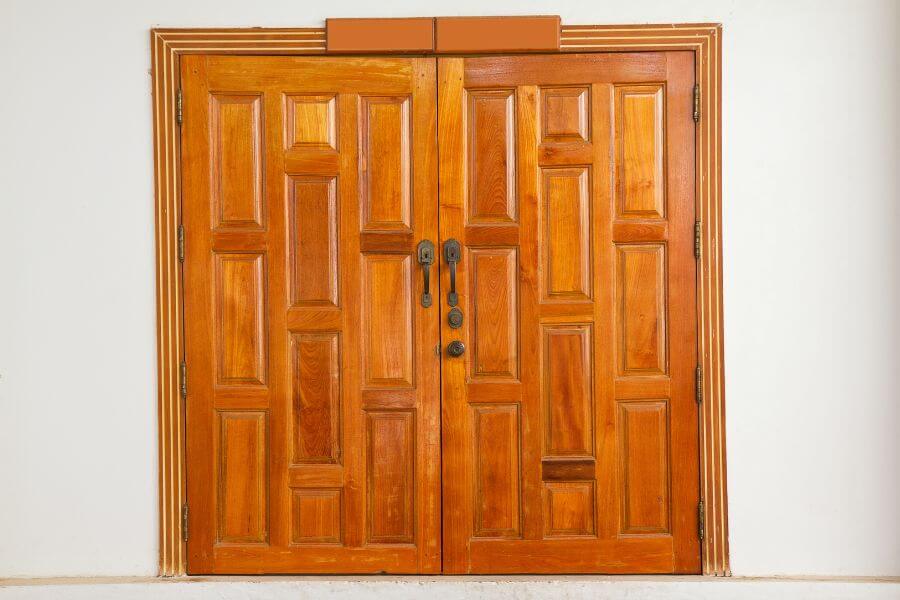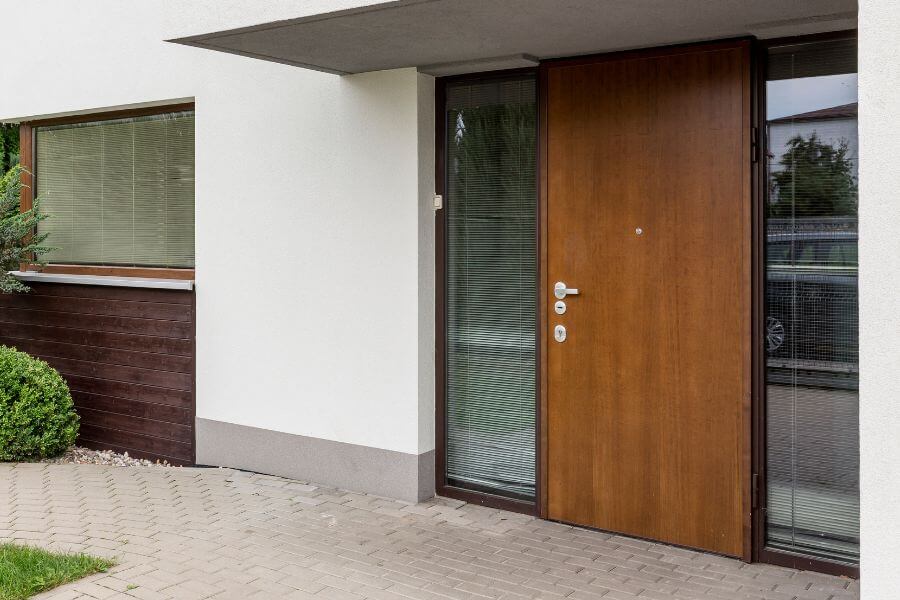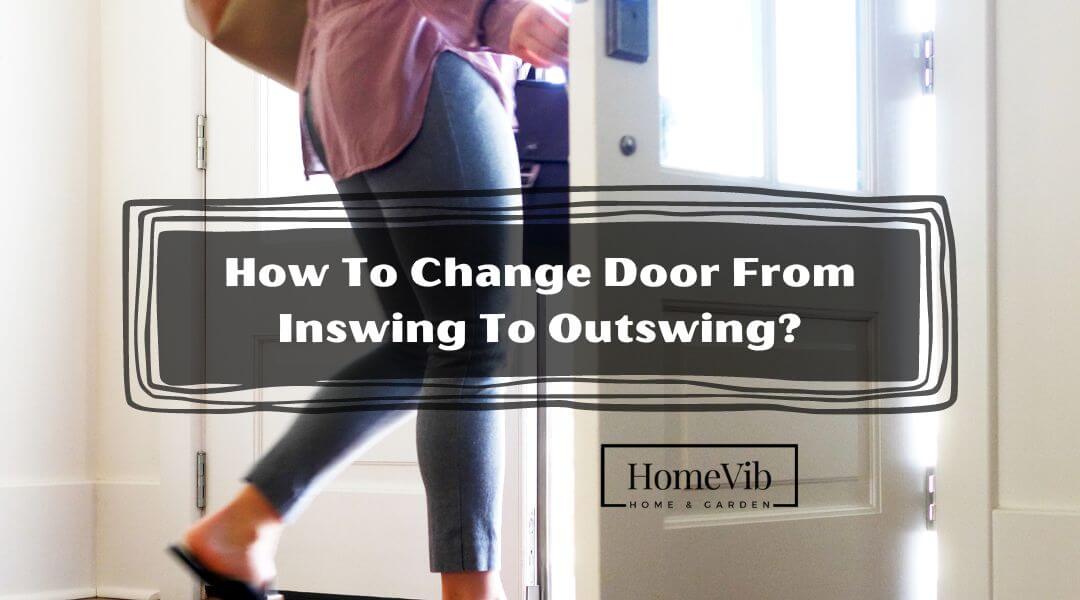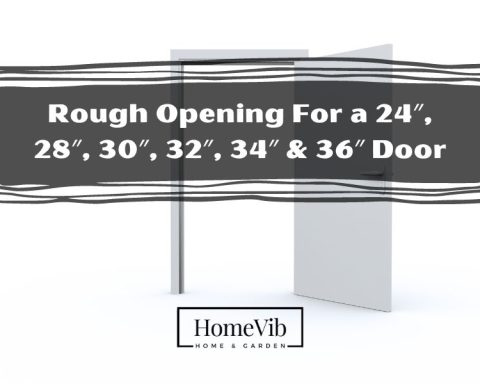Every house or establishment needs a door, which demands extensive maintenance. A door may slide inward or outward.
In the United States, inswing doors are the standard; however, many property owners choose outswing doors, which swing outward while open.
To change a door from inswing to outswing, take the door down, swap out all the hinges, and reinstall it. If appropriate, reverse the door’s hinge mortises. Or easily replace the entire unit.
Let’s estimate how easy it is to change your door from an inswing to an outswing as a DIY project!
Which Is Better, the Inswing Or the Outswing Doors?
If an individual has to choose, outswing doors are preferable.
In extreme conditions, outswing doors are more insulated to the inside of the house. As a result, they have a more challenging time being breached by water or wind due to the barrier structure and fundamental physics.
On the other hand, design features, such as inswing doors, are more susceptible to wind and water.
Out-swinging doors have two security drawbacks and one benefit. First, the door must remain closed even if the hinges are to be removed because the hinges are on the outside.
In addition, the hinge plates will include a locking feature.
The gap between the door and the jamb makes the door latch more susceptible to cutting and jimmying. Usually, a metal plate covering the latch area is used to protect this.

Out-swinging doors can, therefore, be secured while having the benefit of being far more difficult to “kick in.”
In truth, some schools in the US had steel outswing doors, steel jambs, and solid concrete walls. None of these features have ever been breached throughout the school’s history.
However, in some cases, it depends. For example, do you seek security when the door is closed or strive to be secure after opening the door?
During the opening of the door. The swing should be placed internally for maximum security. The individual who is allowed to push a door opens it.
The moment the door is shut (you are either not at home or are hesitant to open the door to a stranger).
Using an out-swinging door is the safest method. An out-swinging door is more of a challenge to kick open because the stop is located on the inside, which presents additional resistance.
In selecting a lock. You can only appear more difficult to break into than your neighbors with your outward-swinging door.
Most doors and jambs will yield with a strong kick if you know how certain locks are simpler to pick than open with a key.
Inswing Doors

An inswing door swings forward and out from you into the inner space you are entering.
Most home doors, if you’re referring to those, swing inward. Two of the key explanations are:
- Kicking in is simpler than prying the door in an emergency.
- It will allow you to attach an outswing storm door to it.
A person cannot block your escape in a fire or other emergency by blocking an inswing door outside with boxes or other heavy objects.
In a residential setting, this kind of swing will enter the house if you are positioned outside. But first, you’ll have to open the front door to access the house.
Advantages of Inswing Doors
- Because they swing into the property, inswing doors are more hospitable to visitors.
- It appears you welcome someone inside because of the internal swooping motion.
- Inswing doors will remain able to open inwards regardless of whether a snowstorm covers the access to your home.
The front doors of many Americans typically open inward, and they frequently claim that this is for security since the hinges stay on the inside of the door frame.
However, to prevent weather from getting beneath the door, such doors typically include a shelf, generally a piece of wood or a concrete structure, in front of the doorway.
In the US, the direction of building codes often regulates door swings. Exterior doors of public buildings swing out to allow an immediate departure in an emergency.
As people escaping a fire have a clear, unimpeded passage down the hallway toward any marked exits, interior doors swing into the area they are attached to so that open doors do not obstruct the egress line.
However, the Building Code or the Residential Building Code operates when it comes to doors and door swings. Therefore, an IBC/IBC-based coding is the standard, at least in the US.
There is one exception: the door may swing inwards if the structure or space occupancy is low enough. It’s fascinating to observe that most residences fall within this group.
Outswing Doors

It is an outswing door if you pull it away from the interior of the place you are facing but towards you.
Despite being positioned differently, those hinges are the same as those on inswing doors. Additionally, outswing door frames usually have a doorstop on the end closest to the room to protect the door from being pulled in.
Outswing doors might be ideal for residents in hurricane-prone locations. However, an inswing door might be quickly forced open by tropical storm gusts, but not an outswing door.
Some home builders believe an outswing door is a better option for security because it is less likely to be pushed open.
However, outswing doors are still almost insusceptible to being kicked in by an attacker. As a result, non-removable hinges and screws are made explicitly for an outswing door’s barrier.
Advantages of Outswing Doors
- Outswing doors allow easier access to the outside, and any moisture on them stays outside, but the downside is that they catch the breeze and should be locked in these conditions to protect the doors.
- It is necessary for a commercial facility. Someone might feel trapped inside if the gate opens in a snowy area. Almost any door slab can be specified with outswing doors.
- An outward swinging door has no requirement for interior dead space where the door must be able to swing freely.
As mentioned above, doors on commercial structures in the US must swing outward when they are opened. This is so because commercial systems are more likely to house large gatherings.
In the event of a commotion brought on by a fire, the mob might push over too far and prohibit whoever is at the doorway from opening it if the door swings to the inside.
Note: When installing them, outswing doors are more expensive. This is because the components needed to allow out the swing are a little more costly than a typical hung door.
In several countries, particularly Japan and Europe, outswing doors are advantageous for:
- Space and Convenience
- Keep the dust and dirt away
- Less safety concern
How To Change Door From Inswing To Outswing?
Can the inswing door be used for the outswing? Can you outswing the exterior door?
Yes, you can adjust the door to open outward rather than inward.
In that case, provided you have all the necessary clearances on the opposite side, you’re okay with the door’s swing being flipped (depending on the opposite hinge side).
Here are some of the steps to follow:
Step 1: Removing the casing from both sides of the door jamb and using a saw to cut through all of the fasteners—nails, screws, and shims—is the simplest way to accomplish this.
Step 2: Use the same method with the thinnest blade if the threshold is separate or caulked. Perform the threshold first if you are aware of this beforehand.
Step 3: As the cutting continues, you might need temporary support to keep the door in the jamb.
Step 4: After cleaning that opening, you have a pre-hung door prepared to be fitted correctly on the other side of the rough hole. If meticulously executed, this installation will appear to be the original.
If you need the necessary clearances or can’t live with the hinges on the opposite side, things get considerably more complicated and much more intricate to perform successfully. So, it is safer to change the door and jamb.
Hinge Protector in Adjusting The Door
Typically, they cannot be replaced after a hinge has been placed. Instead, limited set screws drilled into the hinge knuckle serve as hinge protectors, which seem to be devices that stop the pin of a hinge hung on the outside of the jamb from being withdrawn.
When pressed inward, the screw jams into the pin’s slot, preventing the pin from being released.
The typical person would have difficulty installing such positioned screws into a hinge after the occurrence. Typically, they are an integral part of the “security hinge.”
How To Make an Inswing Door an Outswing?
To convert an in-swinging door to an out-swinging door, remove the door,
Replace it after removing each hinge. Reverse the hinge mortises on the door if required. Or you could replace the entire item.
An outside door frame is joined and fixed with a rabbet (a large notch is carved into it), not detachable, so the door fits into it. It’s constructed vastly differently.
We can elaborate on this further with the guidelines below:
Step 1: An interior door’s swing can be modified by turning the hinges in the other position and notching out the jamb as needed for the hinges and strike.
Step 2: An exterior door’s swing could only be changed by removing a sizable frame piece since the weatherstrip groove would be on the wrong end.
Keep in mind:
- The inner side would have a significant gap area caused by the prior door location.
- The sill’s threshold would need to be in alignment.
- It might catch water.
Step 4: By moving the hinges in the opposite direction and notching out the jamb as needed for the hinges and strike, you can alter the swing of an interior door.
In Using The Current Doors
You can use the present doors depending on how they were built, but doing so would need a slightly different procedure and would not be ideal.
An outswing door would also benefit from hinges with non-removable hinge screws, as this would prevent thieves from simply ripping the nails off and opening the door from the hinge edge. But, again, these hinges should be made of reasonably solid brass or stainless steel, not plated.
While creating a new unit from scratch is more challenging, making a frame to match an existing door is more feasible.
Keep in mind: Assembling half of a unit from preexisting (probably fabricated to various standards) elements certainly needs additional labor time.
In Replacing The Whole Door Unit
A manufacturer or store that produces and hangs doors will have a set of universal specifications for all the components they produce.
Still, these specifications may change over time, and various manufacturers may have different criteria, so replacing the whole unit is necessary.
How Do You Reverse a Prehung Door?
Depending on the door’s design, you can.
- You must rehang the door by chiseling the new hinge sites and replacing the old places.
- Removing the trim and paying to flip the door around can only be done this.
- The stops must be removed and installed again on the other side of the door, and the hinges must be turned around.
- After that, fill the old hinges and mortise the new ones into the casing.
- As a result, the tiny portion of the door’s mortise that conceals the edge of the hinge will be removed, exposing the mortise from the other side.
- Prime and paint.
As you can see, it is possible, but it is typically not a DIY effort. I suggest leaving it to a pro unless you know woodworking and other related areas.
Why Are Outswing Doors More Expensive?
Outswing Doors are more expensive because they include characteristics that make it conceivable to give greater protection.
These doors provide stronger defense against extreme weather conditions and invaders.
- Door Mechanism
- Features that resist fire
- Security locks
- Entryway Threshold
- Grade 1 Deadbolt
- Impact-proof Glass
- Security Fence
The materials used to build a door frame contribute to the high cost. Steel, wood, and fiberglass are the most frequent materials for outward-opening doors.








